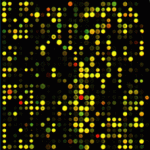Genomics
|
10 may 2012 16:35:05 |
| Unique core genomes of the bacterial family vibrionaceae: Insights into niche adaptation and speciation (BMC Genomics) |
|
Tweet Background:
The criteria for defining bacterial species and even the concept of bacterial species itself are under debate, and the discussion is apparently intensifying as more genome sequence data is becoming available. However, it is still unclear how the new advances in genomics should be used most efficiently to address this question. In this study we identify genes that are common to any group of genomes in our dataset, to determine whether genes specific to a particular taxon exist and to investigate their potential role in adaptation of bacteria to their specific niche. These genes were named unique core genes. Additionally, we investigate the existence and importance of unique core genes that are found in isolates of phylogenetically non-coherent groups. These groups of isolates, that share a genetic feature without sharing a closest common ancestor, are termed genophyletic groups.
Results:
The bacterial family Vibrionaceae was used as the model, and we compiled and compared genome sequences of 64 different isolates. Using the software orthoMCL we determined clusters of homologous genes among the investigated genome sequences. We used multilocus sequence analysis to build a host phylogeny and mapped the numbers of unique core genes of all distinct groups of isolates onto the tree. The results show that unique core genes are more likely to be found in monophyletic groups of isolates. Genophyletic groups of isolates, in contrast, are less common especially for large groups of isolate. The subsequent annotation of unique core genes that are present in genophyletic groups indicate a high degree of horizontally transferred genes. Finally, the annotation of the unique core genes of Vibrio cholerae revealed genes involved in aerotaxis and biosynthesis of the iron-chelator vibriobactin.
Conclusion:
The presented work indicates that genes specific for any taxon inside the bacterial family Vibrionaceae exist. These unique core genes encode conserved metabolic functions that can shed light on the adaptation of a species to its ecological niche. Additionally, our study suggests that unique core genes can be used to aid classification of bacteria and contribute to a bacterial species definition on a genomic level. Furthermore, these genes may be of importance in clinical diagnostics and drug development. |
| 295 viewsCategory: Genomics |
 Improving ancient DNA read mapping against modern reference genomes (BMC Genomics) Improving ancient DNA read mapping against modern reference genomes (BMC Genomics)Genome wide response to dietary tetradecylthioacetic acid supplementation in the heart of Atlantic Salmon (Salmo salar L.) (BMC Genomics) 
|
| blog comments powered by Disqus |
MyJournals.org
The latest issues of all your favorite science journals on one page
The latest issues of all your favorite science journals on one page



